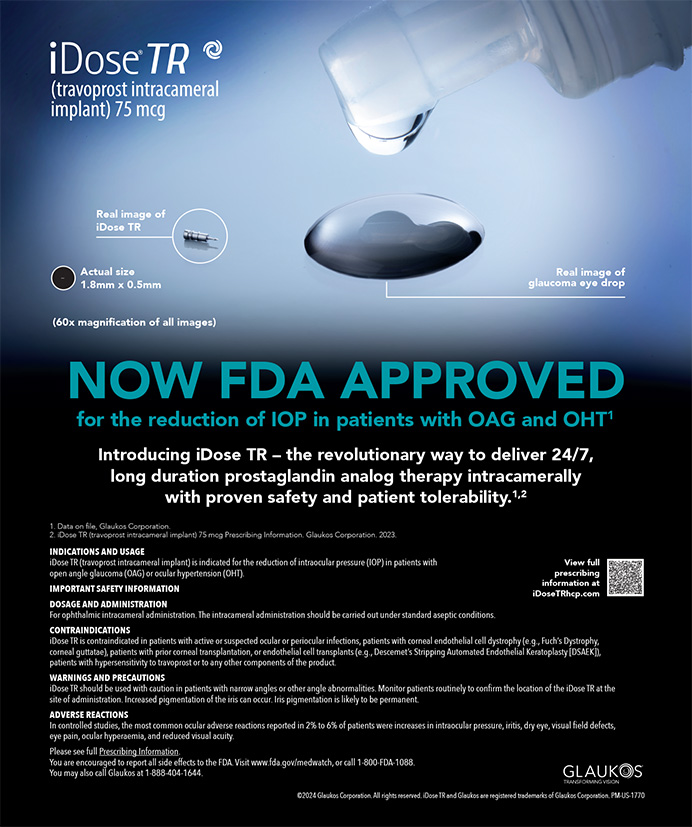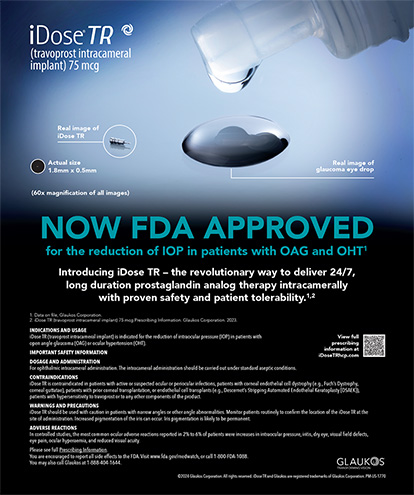
The introduction of the EVO ICL (STAAR Surgical) in the United States was a milestone in refractive surgery. The technology addresses several limitations of its predecessors.
KEY ADVANCES
The EVO ICL’s design retains the same biocompatible Collamer material as the original Visian ICL (STAAR Surgical) but features a central port to improve aqueous flow. This modification reduces the risk of cataract formation, particularly in cases where the postoperative vault is shallow. Additionally, the latest design offers a broader range of refractive correction by including toric models for astigmatism correction.
The EVO ICL widens the pool of candidates for refractive surgery. The lens is a viable option for individuals for whom LASIK is contraindicated due to thin corneas and those whose prescriptions are too high for LASIK or PRK. Additionally, in patients with a family history of keratoconus, corneal laser refractive surgery (LASIK or PRK) may be risky, and the EVO ICL may be a suitable alternative. The implant’s ability to correct high degrees of myopia and astigmatism without altering the cornea makes it an essential tool in the refractive surgeon’s arsenal.
PATIENT SATISFACTION AND CLINICAL OUTCOMES
My patients have been highly satisfied with the EVO ICL and often achieve 20/15 or 20/20 UCVA. Although some patients have reported minor glare from the central port, this side effect usually diminishes within a few months and rarely affects their ability to perform the activities of daily living. Preoperative counseling about potential glare helps set realistic expectations and promote patient satisfaction.
IDEAL CANDIDATES AND CONTRAINDICATIONS
Ideal Candidates
The ideal candidates for an EVO ICL are between the ages of 21 and 45 years. The lens may be used off-label in patients beyond these age limits if certain criteria, such as a stable refraction for at least a year and sufficient anterior chamber depth, are met.
Contraindications
Contraindications for the lens include glaucoma, uveitis, cataracts, narrow angles, or pregnancy/nursing. The anterior chamber angle must be open on gonioscopic examination, and the eye should be free of peripheral anterior synechiae.
ICL SIZING
Accurate sizing of the ICL is critical to achieving optimal surgical outcomes. The ideal postoperative vault ranges from 250 to 750 µm. Improved aqueous flow through the central port gives the EVO ICL some flexibility with lower vaults.
The STAAR-Online Calculation and Ordering System nomogram is based on white-to-white measurements with the Orbscan (Bausch + Lomb) and remains a foundational tool for ICL sizing. Many practitioners, however, favor more advanced technologies for white-to-white measurements such as the IOLMaster 700 (Carl Zeiss Meditec) and Pentacam (Oculus Optikgeräte). Careful cross-referencing with other data points may be necessary for accurate sizing. Manual calipers can be useful for surgeons who lack access to high-end equipment.
I use the Least Absolute Shrinkage and Selection Operator formula as well as the STAAR-Online Calculation and Ordering System nomogram. In my experience, this dual approach increases the precision of postoperative vault size prediction, which is critical for avoiding complications such as angle closure and cataract formation.
Other notable nomograms and tools for ICL sizing include the following:
- ICL Guru (Revai), developed by Roger Zaldivar, MD, MBA, which utilizes AI;
- Iclsizing.com, developed by Dan Z. Reinstein, MD, MA(Cantab), FRCSC, DABO FRCOphth, FEBO; and
- Ultrasound biomicroscopy with devices such as the ArcScan Insight 100 (ArcScan), Aviso (Quantel Medical), Eye Cubed (Ellex), UBM Plus (Accutome), and VuMax HD (Sonomed).
These tools can increase surgeon confidence in preoperative ICL sizing. (Editors’ note: For more on this topic, read “Nomogram’s for ICL Sizing” from CRST’s May issue.)
PHAKIC IOLS VERSUS LASIK AND PRK
For patients with thick corneas and low myopia, LASIK remains my preference. For those with high myopia or thin corneas, however, I find the EVO ICL offers greater accuracy and a lower risk of inducing dry eye and corneal haze than PRK. Patients with severe dry eye disease may benefit more from the EVO ICL because no corneal manipulation is required.
ICL SURGERY IN PRACTICE
Integrating ICL surgery into a practice involves first ensuring the availability of a suitable surgery center and trained staff. I began by identifying patients interested in the technology and meeting the certification requirements. Success depends on effective communication of the benefits of and expectations with ICL surgery.
THE BROADER CONTEXT OF REFRACTIVE SURGERY
Phakic IOLs, particularly the EVO ICL, can be a highly effective solution for patients who are ineligible for LASIK or PRK. The lenses can provide excellent visual outcomes, and they expand the pool of candidates for refractive surgery. As surgical techniques are refined and new technologies are developed, I expect phakic IOLs to maintain an important role in vision correction.




